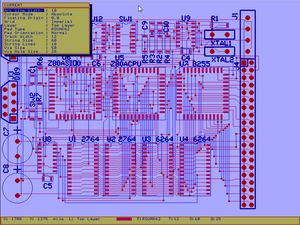Software:Autotrax
 Autotrax freeware versions 1.61ND running in a Virtual Machine (VM) on Windows 7 | |
| Original author(s) | Protel International Pty. Ltd. (now Altium Ltd.) |
|---|---|
| Initial release | 1985 (as Protel PCB), 1988 (as Autotrax) |
| Stable release | 1.61
|
| Operating system | DOS |
| Platform | IBM PC and compatible |
| Type | EDA |
| License | Commercial proprietary software |
| Website | techdocs |
Autotrax was a free software application that ran on DOS on an IBM or compatible PC. It was designed by Protel Systems (now Altium), and was one of the first professional printed circuit board CAD applications available for personal computers. It is a freeware download and also available in a stripped-down version marketed as Easytrax.
History
In 1985, Protel Systems developed the DOS-based PCB design tool Protel PCB,[1] which was sold only in Australia .[2][3] Protel PCB was marketed internationally by HST Technology since 1986.[3] In October 1986 the San Diego-based ACCEL Technologies, Inc. acquired marketing and support responsibilities of the PCB program for the US, Canada and Mexico under the name Tango PCB.[3] combining it with their own Tango Route. In 1987, Protel launched the circuit diagram editor Protel Schematic for DOS.
In 1988 the company launched Autotrax for DOS in the US as well.[1] A stripped-down version of Autotrax was marketed as Easytrax. Autotrax was sold throughout the world until the company ported the application to Windows 3.1 to create the first Windows-based PCB CAD tool, Protel Advanced Schematic/PCB 1.0 for Windows in 1991, which was the forerunner to the software Altium Designer.
Overview
Protel Autotrax runs under DOS. It will run under Windows 98 and XP but only as a console window.[4] The program is primarily keystroke driven but to aid memorization a menu appears in the upper left corner of the screen whenever a command is issued. Selection of elements within the circuit board is accomplished almost exclusively by using the mouse. These apparent limitations mean that users quickly became good at driving the program and disinclined to change to anything newer and, in practice, slower.
The native file format for Autotrax is PCB File 4. Protel also produced a less expensive, cut-down package called Easytrax. This was later made available free, while Autrotrax still required a license; now both are free. Easytrax is identified by "PCB File 5" in its file headers and differs primarily in not allocating hole sizes to pads. The native file format for Autotrax and Easytrax is based on 1 mil (0.001 inch) increments, although the package shows measurements in millimetres if metric is selected. The native file format allows for most of the information needed to manufacture basic PCBs except that it does not allow for non-plated-through holes. This is because a de facto industry standard has emerged which assumes that if a pad is smaller than its associated hole, the hole is not plated through, while Autotrax will only permit pads that are at least 2 mil larger than the hole diameter.
Two bugs in the Protel Autotrax format have to do with octagonal pads, which on inspection can be seen to be not quite regular octagons, and string sizes. In Autotrax, string sizes are only ever displayed in multiples of 12 mil, so specification of a string size as something other than a multiple of 12 mil may lead to incorrect import into another package.[5]
Many PCB manufacturers in Australia and some PCB manufacturers in Asia will still accept boards in native Protel Autotrax format rather than requiring export to PCB industry standard Gerber format. Autotrax will run in a DOS window under Windows 9x and Windows NT up to XP. It does not run on Windows Vista and later,[citation needed] but can be run successfully using generic VESA video drivers in a DOS virtual machine.
References
- ↑ Jump up to: 1.0 1.1 "History - PCB Design Tools - EDA Software". https://www.altium.com/company/about-altium/our-history.
- ↑ "Nick Martin .: SemiEngineering.com". http://semiengineering.com/kc/people.php?pid=11492.
- ↑ Jump up to: 3.0 3.1 3.2 Tango-PCB - Reference Manual - Version 3 (Printed manual). ACCEL Technologies, Inc.. 1987-12-01. p. front matter. "[…] CREDITS […] Program Design: Nick Martin […] Reference Manual: Tom Lupfer […] Production: Cathy Vermillion, Walt Foley […] Product Management: Tom Lupfer, Ray Schnorr […] Derivative Manual Copyright (c) 1986 ACCEL Techologies Inc. […] Original Manual Copyright (c) 1986 HST Technology Pty Ltd […] Software Copyright (c) 1985, 1986 Protel Systems Pty Ltd […] The History of Tango-PCB […] Tango-PCB is a personal computer-based software CAD package for designing Printed Circuit Boards. It was originally written in 1985 by Nick Martin, of Australia, and sold under the name of PROTEL-PCB. HST Technology Pty Ltd maintains sole-worldwide marketing rights for PROTEL-PCB. In 1986, ACCEL Technologies, Inc., of San Diego, California, acquired marketing and support responsibilities for the product in the U.S., Canada and Mexico. […] Working together, engineers from ACCEL, HST and Protel Systems have implemented numerous enhancements to the original product. The Reference Manual was re-written for the American market. ACCEL markets the product under the name Tango-PCB. Tango and Tango-PCB are trademarks of ACCEL Technologies, Inc. PROTEL is a trademark of Protel Systems Pty Ltd. […] ACCEL Technologies, Inc. […] 7358 Trade Street […] San Diego, California 92121 […] (619) 695-2000 […]"
- ↑ Benchoff, Brian (10 November 2016). "Creating A PCB In Everything: Protel Autotrax". https://hackaday.com/2016/11/10/creating-a-pcb-in-everything-protel-autotrax/.
- ↑ "PROTEL Autotrax - known issues, and unobvious solutions". https://airborn.com.au/layout/autotbug.html.
External links
- Protel Autotrax utilities, from Jim Patchell
- More Protel Autotrax utilities, from Richard Aston (archived)
- A laser plotting utility for Protel Autotrax
- Newer (VESA) video drivers for Protel Autotrax
- A HowTo for using Protel Autotrax under SuSE Linux and DOSemu
- Protel Autotrax companion programs - Directly generate RS274X gerbers from Autotrax PCB files, rotate PCBs, etc, From Les Hildenbrandt
 |
 |


